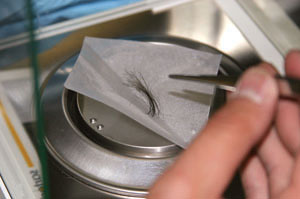Senior Reporter
Advisory Board Could Recommend Hair Testing for Drivers This Summer

ROCKVILLE, Md. – An advisory board that explores scientific evidence to support possible changes or additions to federal drug testing requirements is on track this summer to issue a recommendation that hair specimens be approved for the pre-employment screening of truck drivers and other “safety sensitive” federal workers.
“I’m 99% sure that we’re going to approve hair testing,” Ronald Flegel, chairman of the nine-member advisory drug testing board and a division director for the Substance Abuse and Mental Health Services Administration told Transport Topics. “I’m comfortable that we’ve eliminated the obstacles to approving hair testing.”
Meeting at SAMHSA headquarters here June 12, the board scheduled meetings for Aug. 6-7 to discuss public comments, finish deliberating the pros and cons of hair testing, and then take a vote via secret ballot on a final proposal that would be sent to SAMHSA Administrator Pamela Hyde.
If Hyde agrees, the recommendation would be forwarded to the Department of Health and Human Services, which would give final approval for proposed hair testing guidelines.
The board has been studying hair testing for the past two years, including combing the results of more than 1,200 peer-reviewed papers on the subject published in professional journals, said Janine Cook, SAMHSA’s designated federal official to the board.
Before that, the board examined hair testing from 2004 to 2008, concluding at the time that there wasn’t enough scientific evidence to warrant approval.
In an audio briefing to the board, Patrice Kelly, acting director of the Department of Transportation’s Office of Drug and Alcohol Policy and Compliance, said her agency views drug testing as a “serious safety issue.”
DOT typically adopts, but tailors some of the procedures of HHS drug testing requirements to transportation workers. The HHS and DOT’s current drug testing protocol is to use urine samples.
Kelly said that in 2014 transportation-related employers made 6.3 million drug tests, yielding a positive average drug test rate of 1.79% reported by the 30 HHS certified laboratories during the last half of the year.
The highest number of positive results, respectively, were for marijuana, amphetamines, and cocaine, Kelly said.
Last month, SAMSHA issued a request for scientific and other information from the public and stakeholders about hair testing. Board members said at the meeting that they plan to extend the public comment period by 30 days, until July 29.
Flegel said the board, which includes lab executives, is largely convinced that hair testing should be allowed but wanted to make sure it had all the evidence available before making a final decision.
Slow progress and an alleged lack of transparency have frustrated some in the trucking industry.
As a result, some carriers have been using hair specimens for testing would-be employees before administering urine tests. They claim hair samples are more reliable than urine because they can identify drug use dating as far as 90 days.




